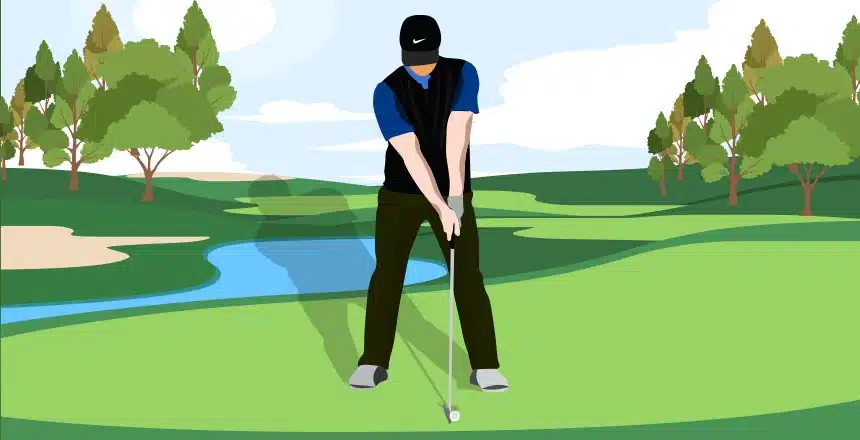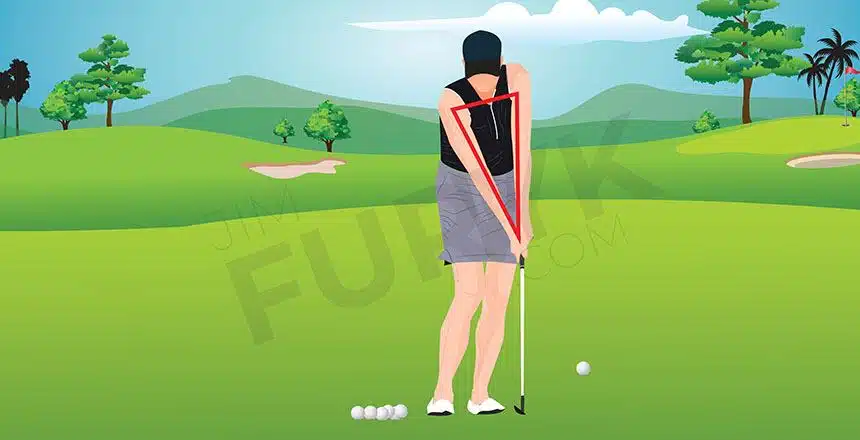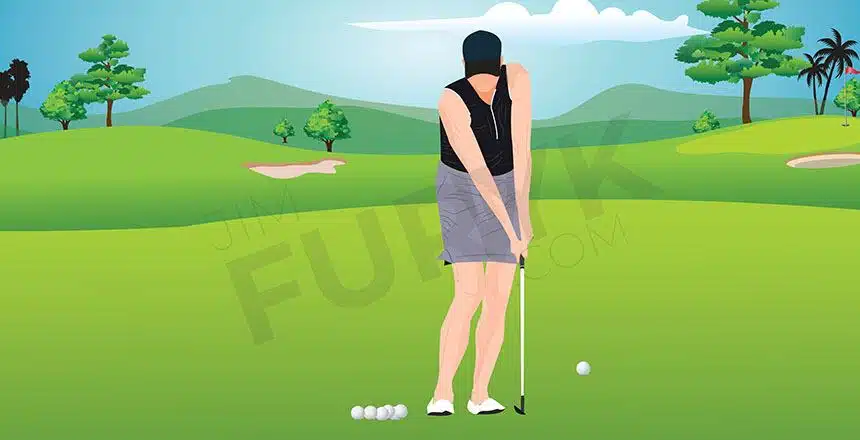Every golfer truly committed to the sport wants to know the best golf chipping tips from the pros. In my opinion, that’s not surprising at all since the world’s top golfers ace it from the tee to the green. Even their approach shots look so flawless and effortless!
We consider these Tour-grade skills as one of those things that pro-level players have acquired through intense training and plenty of practice. More average golfers, on the other hand, cannot achieve what Tour players are able to master. However, that doesn’t mean you give up and never try! And this extends to finding out how to improve your chipping!
Dustin Johnson describes his chipping technique in this article here. His process involves…
- Placing the golf ball back in a narrow stance where most of the weight rests in the left leg (remember that Dustin Johnson’s an elite left-handed player, so your weight should favor your right leg if you’re a right-handed golfer).
- Then he angles his knees slightly in the direction of the target.
- He ensures the least amount of swing sway and hand action.
- He rotates around the left leg during the golf swing but without moving his weight to and fro.
That’s how Dustin Johnson’s chipping shots produced have a low ball flight!
Okay then, how about I break it down for you, so you can understand the basics of how to hit chip shots like a pro!
In This Post
Most Important, Basic Tips for Chipping In Golf
Good chipping is all about proper posture and distance control. The former has a lot to do with your chipping technique, while the latter is determined by how hard you strike the ball.
1. Correct Golf Chipping Technique
Proper Posture
If you ask me or any other golf veteran, he/she will admit to the fact that hitting chip shots is one of the easiest things to do. Since chip shots are very close to the green, a very short swing works the best. Short or long, every correct golf swing sequence begins with a proper posture where you’re bending forward using your hips.
Don’t create a squatty posture, otherwise inconsistent contact becomes inevitable.
Correct Stance and Setup

For both chipping and putting, a smaller stroke movement is essential. And for that, keep your stance narrow and your weight on the front or leading foot.
As for proper setup, position the golf ball slightly behind the stance.
As for your shoulders and arms, these should form a triangle, an intact triangle throughout the swing motion.
The ultimate goal here is for you to produce an angle of attack that’s fairly steep, so the ball (not the ground) makes contact with your golf club first. Speaking of which…
Improve Ball-Turf Interaction

Do you understand how this interaction is supposed to work? With chip shots, the ball gets airborne, even if it’s just for just a short span of time.
So for achieving that upward flight, you have to hit downward. And to do that, the upper body needs to be slightly tilted toward your target. Only then can you create that downward or descending blow!
2. Correct Distance Control
Adjusting or calibrating distance control is the second part of the whole golf chipping process. Keep in mind that a solid foundation in the form of proper posture, stance, setup, and ball-turf interaction paves the way for optimal distance control. So how to calibrate this particular factor for chip shots?
You have to control distance both in the air and on the turf. Otherwise, your chip shots land either too far away from the hole or too short of it.
That in place, I think now would be the right time to talk about which golf club to use for chipping as that club will determine how hard you strike the ball – 7-iron or sand wedge?
If you’re a beginner and/or high-handicap golfer, you should pick 1-2 clubs you’re the most comfortable or consistent with.
As for the others, they go for either lower-lofted 6-iron or higher-lofted lob wedge – it’s all based on how far/close the hole is. When you have plenty of green to cover, a lower loft golf club (6-iron or 7-iron) is the most suitable for allowing the ball to reach that putting surface.
On the contrary, a higher lofted option (56-degree or 60-degree wedge) is best when the pin is closer.
But, once again, if it’s just a normal chip shot, then beginners and high handicappers alike perform better when they choose 1-2 golf clubs they’re the most confident hitting.
Just keep in mind that the higher the loft of your club, the lower the ball flight. The advantage to this is a more consistent stroke. For instance, 20 yards gained with pitching wedge, 30 yards with 9-iron, 40 yards with 8-iron, and 50 yards with 7-iron.
Towel Drill to Improve Distance Control
Improving chipping technique around the green can also mean working on your distance control. And one way to go about it is the Towel Drill method.
Through this particular practice technique, you get to know how hard to strike the golf ball to make it travel the required distance, both in the air and on the ground.
Here are the simple instructions you need to follow for this Towel Drill…
- Lay a small-sized towel on the turf. Place it on your target line between the hole and you.
- Now hit some chip shots and see how the ball is landing on that towel. Watch how much distance does it cover when rolling toward the hole.
- Over time, you’ll get better at determining how far into the green should the towel be for the golf ball to roll closer toward the hole. This means the focus here ought to be the towel and not the hole.
- If the ball flies past the towel, it’s bound to travel beyond the hole. On the other hand, too short i.e. before the towel means the ball ends up short. This way, you can dial in your distance control.
Now here are some really helpful chipping tips to improve short game performance…
Frequently Asked Questions About Golf Chipping
Why is chipping so important?
For PGA Tour players, they simply can’t get away with not acing the chipping technique. However, good chipping is a must even for amateur golfers (mainly high handicappers) since they miss greens at least 2x more than the pros. That means doubling your chances of the most dreaded 3-putt.
Why is your chipping so bad?
There could be many reasons for bad chipping…
- You’re hunching over the golf ball, hence not making solid, clean contact.
- You’re not thinking about the gradient and speed of the greens.
- Lack of swing tempo, rhythm, consistency, etc.
- You’re not practicing enough on that chipping green!
What golf clubs do pros use for chip shots?
For Tour players, it’s all about the type of shot. For example, to gain a high ball flight and then have the ball stop dead, a sand or lob wedge is used. Whereas for bump-and-run kind of a chip shot, the extra loft of 7-iron seems more fitting.
Conclusion
When it comes to golf chipping, the aim is to place the ball as close to the hole as possible. This way, you increase your chances of making more putts, thus saving more strokes.
Amateurs need to do this even more because only a few of them hit their putts from outside a 5-feet distance to the hole. As for when the ball is 3 feet from the hole, your likelihood of sinking more putts drastically improves. But anything beyond 5 feet, the odds significantly reduce.
Therefore, practice as much as you can with the proper chipping technique in mind. Also equally important is improving or calibrating distance control!

